Liberty County Birding Guide
Liberty County’s mild climate makes it a prime location for a wide variety of birds to call home all year round. Step outside at any given time and you are likely to hear their sweet songs. If you’re lucky, you can even spot one by keeping an eye out for vibrant colors and unique feather patterns. Dust off your binoculars and go on an adventure to find some of the various species who call the Georgia coast home! Keep reading to learn more about which ones to be on the lookout for.
Painted Buntings
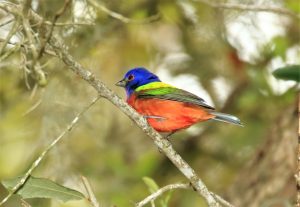
Photo by Jeff Jones
- Migration: Every spring these birds migrate from Florida, the Caribbean Islands and South America.
- Coloring: Mature male painted buntings are vibrantly colored and look as though they have been splashed with paint! The young males and females of all ages are more camouflaged.
- Habitat: Mama buntings build their nests in the Spanish moss of our maritime oaks found on the coast. They are most common in coastal Georgia during the spring and summer habitats.
Redheaded Woodpeckers

Photo by Jeff Jones
- Migration: Redheaded woodpeckers can be found in Liberty County all year round. If you listen closely, their rhythmic pecking will give them away.
- Coloring: Keep an eye out for their red heads. It is the easiest way to spot them!
- Habitat: They prefer to make their homes in open groves or wooded areas, so you are likely to see them in our neighborhoods.
This species is omnivorous. Which means that they can be found dining on earthworms, bugs, seeds and berries! If you want to attract them, have some of these snacks handy.
Great Egret
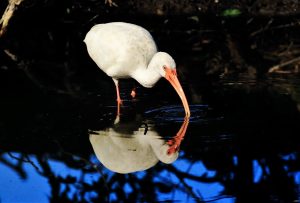
Photo by Jeff Jones
Also known as an Egret or Great White Heron, this is one of our favorite birds!
- Migration: Several shorebirds like the Great Egret, wood storks and white ibis love the marshes, swamps, rivers and canals of coastal Georgia making them year-round residents.
- Coloring: Great egrets are white in color.
- Habitat: These birds are big fans of saltwater and freshwater. They are colonial nesters which means that they typically make their homes by placing stick nests high in the trees. They are more prevalent on islands that are isolated from predators like raccoons!
They feed off of little fish flowing through these bodies of water. Mature birds have no predators and can live well into their 20s.
Fun fact: In 1953, the Great Egret was chosen as the symbol of the National Audubon Society.
Black-Crowned Night Heron and Great Blue Heron
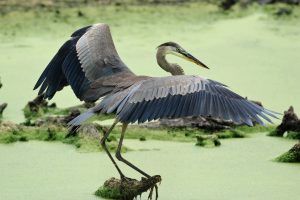
Photo by Jeff Jones
- Migration: They live in all kinds of habitats across the county year-round.
- Coloring: Black-crowned night herons are striking birds that have a black “cap” of feathers on their heads and bright eyes. The great blue herons are a more dull blue-grey and are the largest herons in North America.
- Habitat: Black-crowned night heron and great blue heron are more species of shorebirds that inhabit the low-lying areas on the coast.
You may have seen both species of these feathered friends standing motionless in a ditch or on a dock hunting for their food as they like to dine on fish, frogs, snakes and shellfish.
Ruby-Throated Hummingbirds
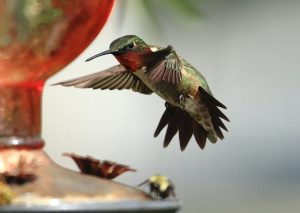
Photo by Jeff Jones
Georgia is home to many species of hummingbirds, and the ruby-throated species is the most common.
- Migration: These tiny migrants arrive in Georgia coast in late February or early March and stay until the fall. Click here to see their migration map!
- Coloring: The name ruby-throated tells you everything you need to know.
- Habitat: Ruby-throated hummingbird can be found flitting around backyard feeders and in gardens. They are attracted to many native plants to the coast like azaleas, honeysuckle and Rose of Sharon!
Roseate Spoonbill
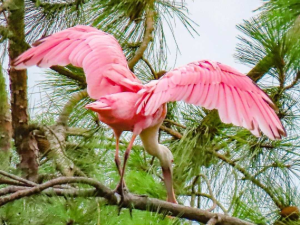
Photo by @2suitcasesfor2years
- Migration: Some roseate spoonbills migrate north for the summer and some are year long residents. It really depends on the bird!
- Coloring: Their pink feathers stand out starkly in our coastal marshes!
- Habitat: Shades of pink feathers can be found all around our marshy areas. Keep your eyes peeled, and you may find a feather that was left behind while soaring through the sky.
Like the herons, egrets and storks, spoonbills eat a diet of shellfish and other water animals. Many people believe that their pink feathers and desire to live in warmer climates suggest they are a relative to the flamingo, but they are not!
Wondering where to go in Liberty County where you are most likely to see some of our feathered friends? We suggest Fort Morris State Historic Site and Cay Creek Wetlands Interpretive Center! While you’re out bird watching, take the opportunity to #ExploreLiberty more by visiting some of our parks.
